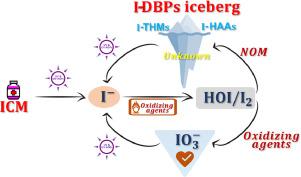Water Research ( IF 11.4 ) Pub Date : 2021-10-14 , DOI: 10.1016/j.watres.2021.117755 Tao Ye 1 , Tian-Yang Zhang 2 , Fu-Xiang Tian 3 , Bin Xu 2

|
Iodinated disinfection byproducts (I-DBPs) formed in water treatment are of emerging concern due to their high toxicity and the tase-and-odor problems associated with iodinated trihalomethanes (I-THMs). Iodoacetic acid and dichloroiodomethane are currently regulated in Shenzhen, China and the Ministry of Health of the People's Republic of China has also been considering regulating I-DBPs. Iodide (I–), organoiodine compounds (e.g., iodinated X-ray contrast media [ICM]), and iodate (IO3–) are the three common iodine sources in aquatic environment that lead to I-DBP formation. While UV irradiation effectively inactivate a wide range of microorganisms in water, it induces the transformation of these iodine sources, enabling the formation of I-DBPs. This review focuses on the fate and transformation of these iodine sources in UV-based water treatment (i.e., UV irradiation and UV-based advanced oxidation processes [UV-AOPs]) and the formation of I-DBPs in post-disinfection. I– released in UV-based treatments of ICM and can be oxidized in subsequent disinfection to hypoiodous acid (HOI), which reacts with natural organic matter (NOM) to produce I-DBPs. Both UV and UV-AOPs are not able to fully mineralize ICM and completely oxidize the released I– to (except UV/O3). Results reveal that UV and UV-AOPs are adequate for I-DBP degradation but require high UV doses. While the ideal I-DBP mitigation strategy awaits to be developed, understanding their sources and formation pathways aids in informed selections of water treatment processes, empowers water suppliers to meet drinking water standards, and minimizes consumers’ exposure to I-DBPs.












































 京公网安备 11010802027423号
京公网安备 11010802027423号